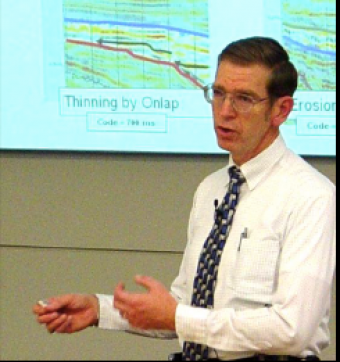Date: November 1, 2016 50min Advanced
Seismic attributes are mathematical descriptions of the shape or other characteristics of a seismic trace over a specified time (depth) interval. Seismic attributes are used to help in mapping stratigraphic features. Seismic attributes are used for qualitative analysis (e.g., data quality, seismic facies mapping) and quantitative analysis (e.g., net sand, porosity prediction).
Divide the class time into three (3) segments: (1) review of the previous exercise, (2) introduce the lecture, and (3) introduce the exercise presented here. The review of the previous exercise has seven (7) slides, and will take ~10 minutes to explain. The lecture has sixteen (16) slides, and will take ~30 minutes to explain. The introduction to this exercise contains six (6) slides, and will take ~10 minutes to explain.
During the exercise introduction, the instructor should walk through the conceptual model (presented below) for the zone of interest.
In summary:
Once the students understand where a good seal and a good reservoir should be located, they will work to identify where both are present (with tracing paper). Then, they consider where a good seal and a good reservoir are positioned on a structural high. The exercise should take approximately 30 minutes.
At the end of this lesson, students should be able to:

This course, based on teaching material from Dr. Fred Schroeder (formerly of Exxon/ExxonMobil), reflects on the geology and geophysics basics for the petroleum industry. General geology and basic geophysics are not required, but helpful with the material.
We encourage the reuse and dissemination of the material on this site as long as attribution is retained. To this end the material on this site, unless otherwise noted, is offered under Creative Commons Attribution (CC BY 4.0) license